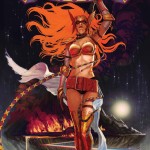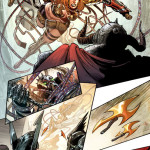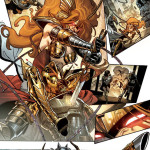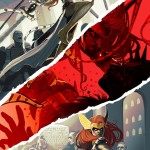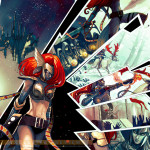I’ve been curious about the Angela: Asgard’s Assassin for a while now, since the Comic Issues folks have such glowing things to say about the series on their podcast. The release of the first graphic novel collecting the story of Thor’s long-lost sister seemed like a really good place to jump on board the bandwagon.
First two impressions: a) Marguerite Bennett (co-writing with Kieron Gillen) is quickly becoming one of my favorite writers.
And b) the artwork on this series is really pretty.
(Trying to explain in detail exactly how an Image character ended up with Marvel will take up too much space. Short version: Todd McFarlane contracted Neil Gaiman to write an issue of Spawn in 1993. Gaiman claimed part ownership of the characters created in that issue – including the angelic bounty hunter Angela – along with a share of any royalties from use of the characters in reprints and toy sales. McFarlane’s legal argument can be summed up as “Nuh-uh!”, and after ten years of litigation and court decisions against him, McFarlane settled the dispute and Gaiman received full ownership of the character Angela, eventually selling the rights to Marvel. The end.)
Angela first appeared in the Marvel Age of Ultron story, and in Original Sin it was revealed that she was the daughter of Odin and Freyja, raised in Heven by the mortal enemies of the Asgardians after everyone thought she’d been murdered as an infant in the war with the Angels. Don’t worry if you’re starting this series without reading the other two, since her backstory is ably summed up by Angela’s best friend and fellow Angel, Sera.
And I have to say that I loved how much of a non-issue Sera’s origin is in this book. No matter who she was supposed to be when she was born, Sera is and always has been Sera, a smart-aleck, wise-cracking magician who cheerfully embellishes the stories she tells about their adventures. She’s also fiercely loyal to Angela, even more so now that she’s died and mysteriously come back to life for reasons even she doesn’t understand (but you’ll find out by the end of the book, oh yes…)
The Angels can’t accept Angela as an Asgardian, and the Asgardians can’t trust someone who was raised by their enemies. Odin insists that his daughter’s going to rejoin the family, so she’s welcomed to Asgard with all the fanfare due to an Asgardian princess, and reintroduced to her mother just in time for the birth of the first child that Odin and Freyja have conceived in centuries.
And of course the first thing that Angela does is kidnap her newborn sister and run for the hills.
Angela has no problem with becoming Asgard’s Enemy #1, but her motives are tied up in the guiding principle of the Angels: everything has a price. Nothing for nothing, you never do a service for someone unless you get something in return, whether it’s saving a life or returning a ball that a kid accidentally kicks in your direction. It sounds like a pretty mercenary outlook, but the Angels actually have a lot of contempt for Asgard and their notions about honor. To them, the Asgards appear incredibly self-centered, since everything is always about them, their honor, their sense of responsibility, and their ideas about what’s right and good (which can change depending on the circumstances), never mind what anyone else might actually need.
With the Angels, you always know where you stand. It’s never about the people involved, it’s only about what’s owed. And you’d better be prepared to pay your debt when it’s called in, because Angels in general (and Angela in particular) have no problem taking their payment in blood.
Gillen and Bennett’s story is a rollicking adventure that moves backward and forward in time, swinging through Heven and Asgard and a poker game with the Guardians of the Galaxy. Angela has a pretty straightforward plan and fairly solid reasons for what she’s doing, but she has a convoluted way of going about it since she can’t risk having some well-meaning person (translation: Thor) figure out what’s going on and try to put a stop to it.
And the art? My goodness, this book is gorgeous. Phil Jimenez does the bulk of the main story, throwing in lots of splashy battle scenes and intricate details, like the tiny designs running along the ribbons that spiral out from Angela’s armor, or the temporary wings that Angela “borrows” from a temple containing the bridal dress of an old fling of Heimdall. Stephanie Hans does the covers and the art for the flashback scenes, and every stylized, dreamlike panel looks like something I’d want to frame and hang on my wall.
The story charges onward to a somewhat happily-ever-after, with a really nasty surprise at the end. The last issue in this collection came out last May and then things just…stopped for a while. 1602 Witch Hunter Angela has some of the same characters, but with a different story and setting. Fear not though, Angela:Queen of Hel (written by Marguerite Bennett with art entirely by Stepanie Hans) starts up this October, so we should get to find out what happened next. From the title, it looks like getting rejected by Heven and Asgard hasn’t sweetened Angela’s temper much. At all.
